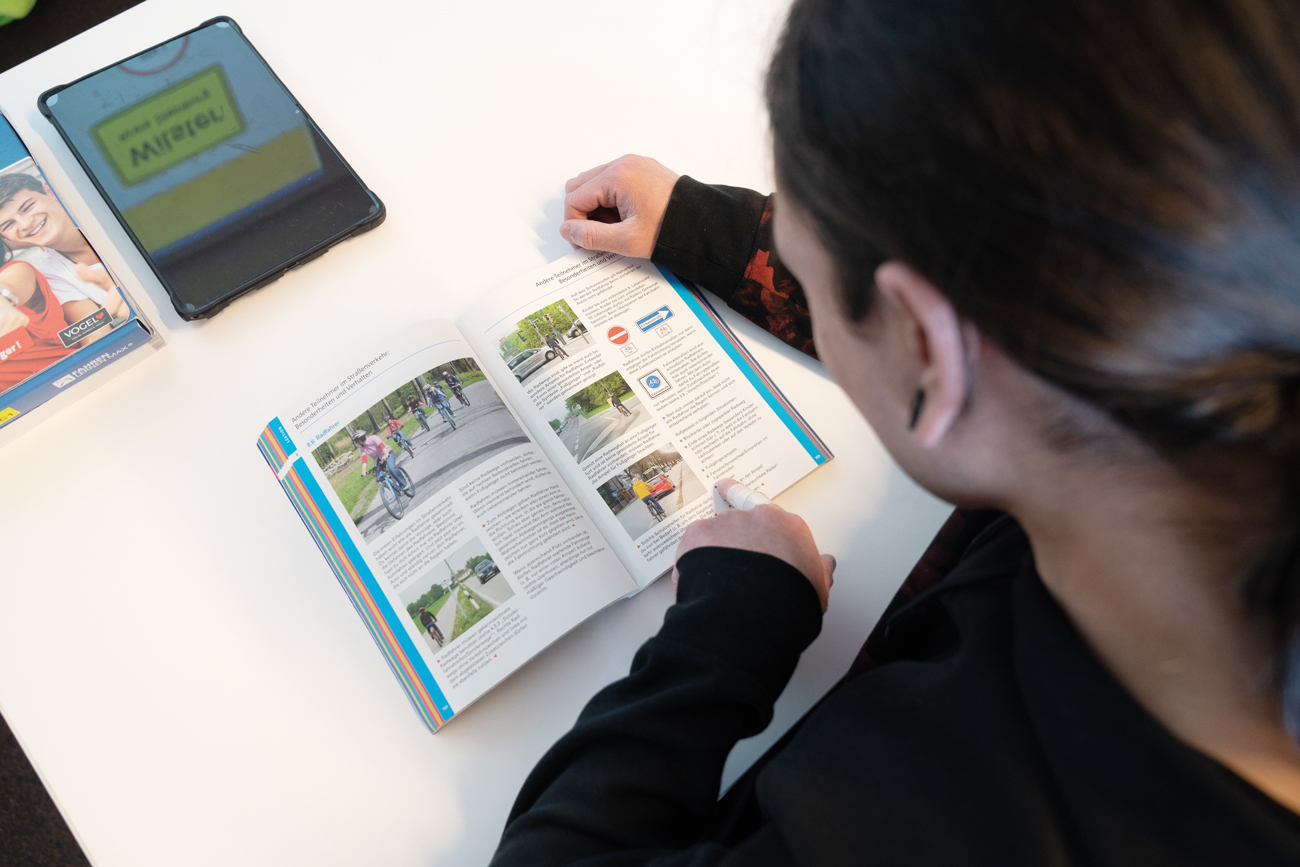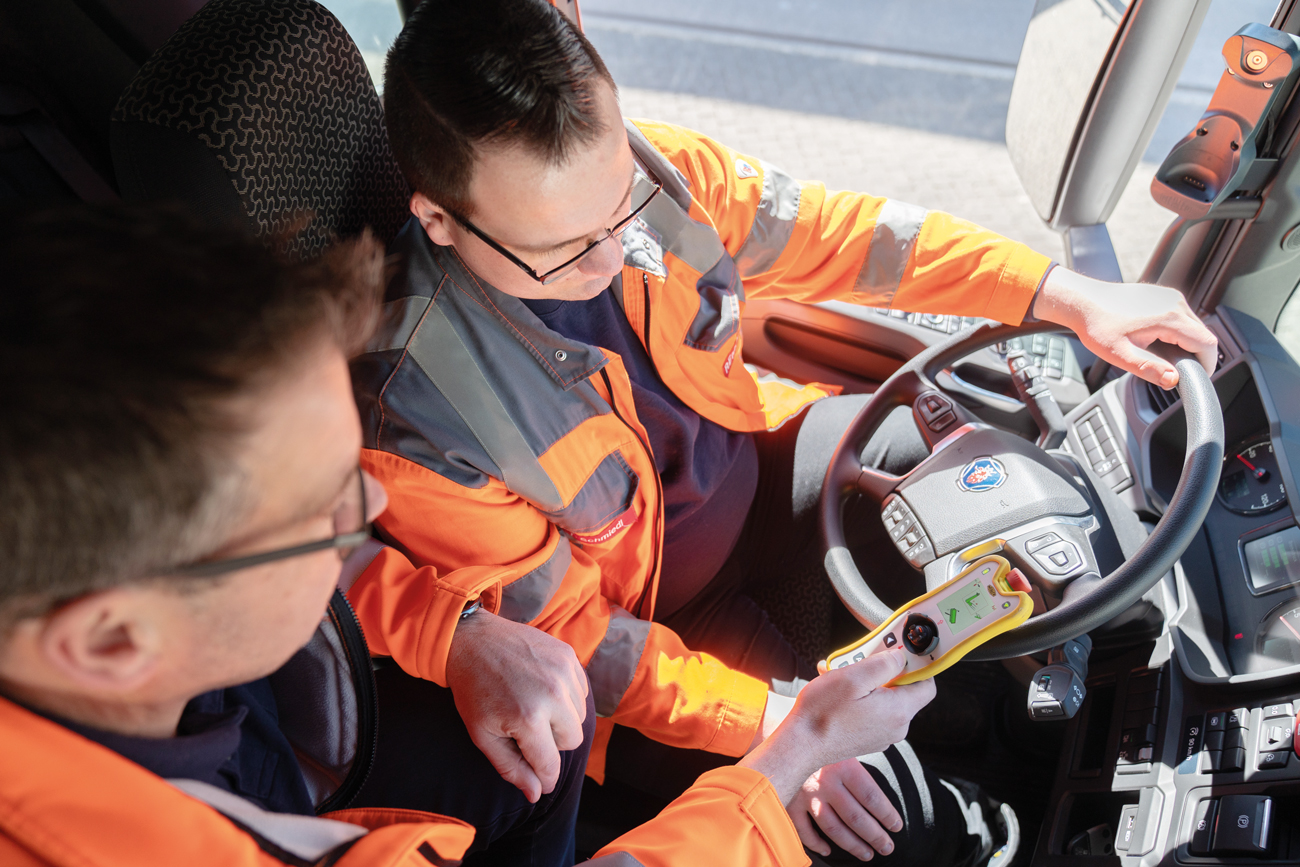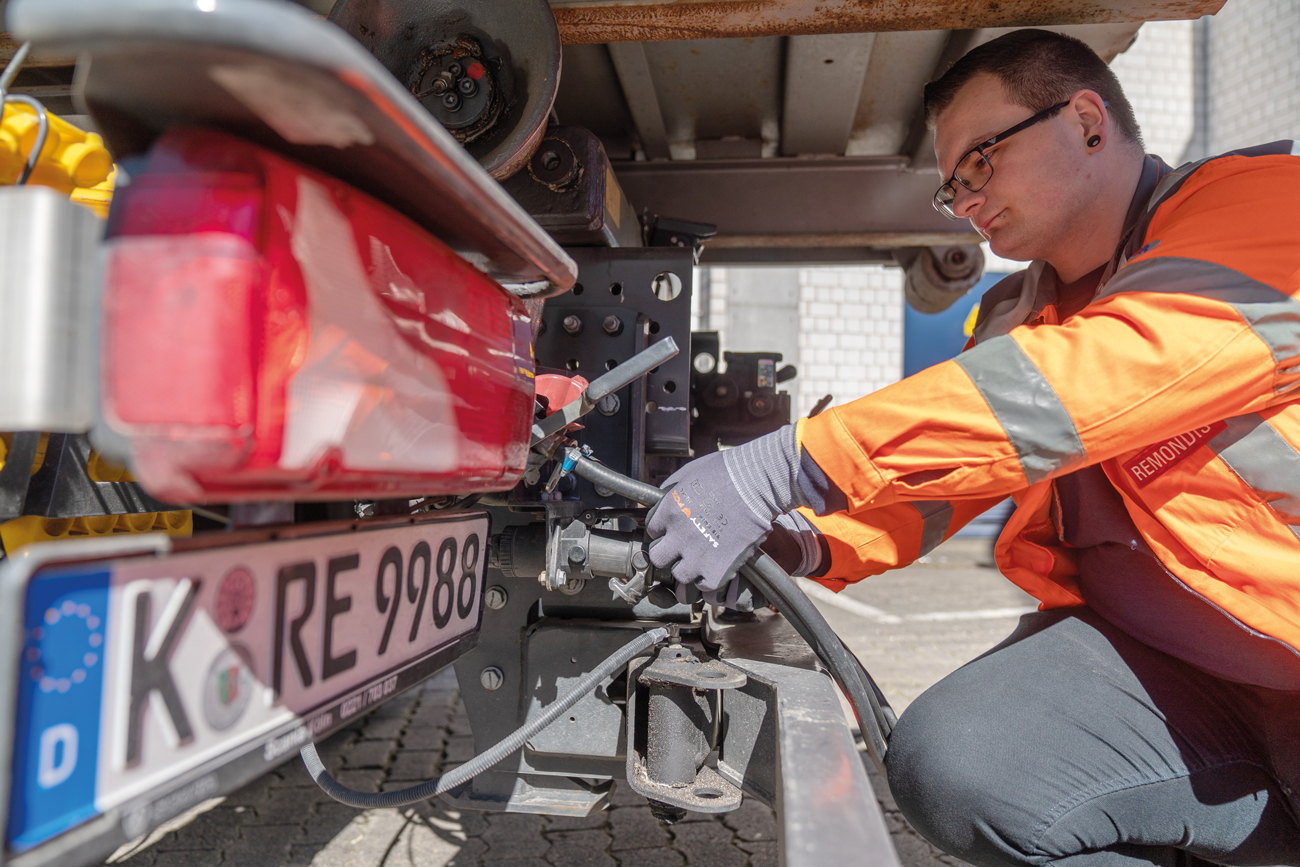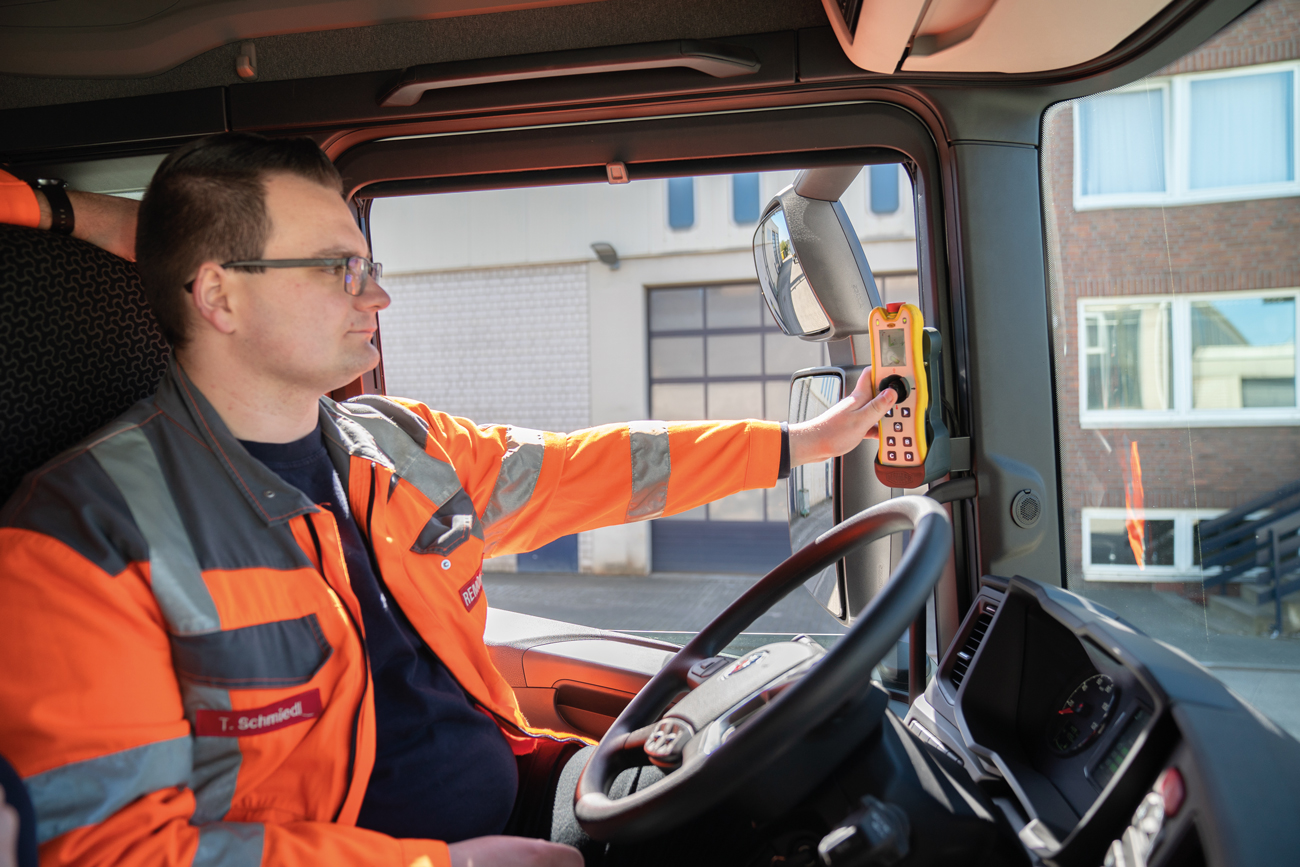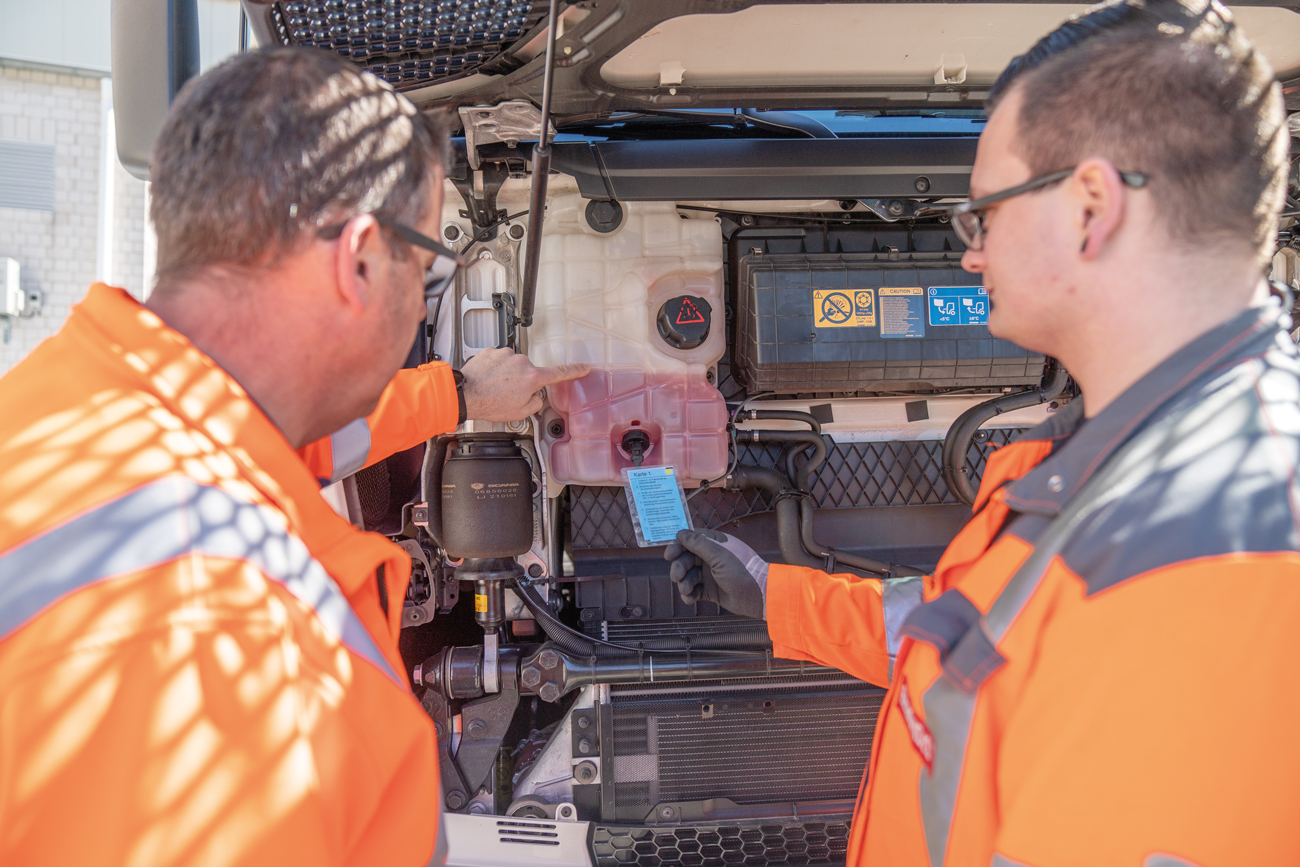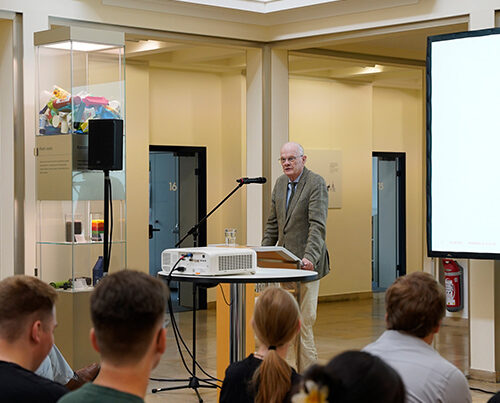More recycling, more complex waste streams – the circular economy has been continuously further developing its business over the last few years. As the levels of complexity have grown so, too, has the demand for logistics and the need for professional truck drivers. And this is precisely where the problem lies. According to the latest report published by the International Road Transport Union, there were around 425,000 unfilled HGV driver jobs across Europe at the end of 2021. This figure is said to have shot up to 600,000 within just a few weeks of the war in Ukraine breaking out. The numbers for Germany speak volumes as well: a further 80,000 truck drivers are needed here and the situation is only going to get worse.

There are not enough new drivers… Every year in Germany alone, at least 40,000 HGV drivers retire and just 20,000 newly trained drivers join the sector.
The main trade associations of the German bus and road haulage sectors, including the BDE [Federal Association of the German Waste Management Industry], drew up a position paper in February 2023 that listed a series of measures and legislative changes that are necessary to counteract the massive shortage of drivers.
So why are there so many unfilled vacancies? The growing demand for transport and logistics services has certainly had an impact as has the planned transport transition. Furthermore, there are not enough new drivers entering the profession to make up for those retiring. Every year in Germany alone, for example, at least 40,000 HGV drivers enter retirement and just 20,000 newly trained drivers join the sector.
Another reason is that the process that people need to go through to get an HGV driving licence is more complicated here in Germany. This is because of the way the European truck driver directive was transposed into German law. As a basic rule, drivers must have an HGV driving licence and a certificate of professional competence (CPC) qualification to be able to transport goods on public roads in the European Union. This qualification can be gained through self-study or by taking part in an accelerated training course with a minimum 140 hours of teaching.
Unlike the other EU member states, HGV driving courses and CPC courses are taught and examined separately in Germany. This means it takes longer and costs more to qualify.
Language is a further obstacle. Foreign HGV drivers are indispensable as a means to overcome the shortage of drivers. Recruiting them, however, is made more difficult as their foreign driving licences are not always recognised. What’s more, the German CPC courses must be held in German. We, though, can travel around Spain, Norway and Poland without a problem – even though we don’t speak all of the languages.
It is essential, therefore, that German HGV driver training courses are reformed so that more vacancies can be filled.
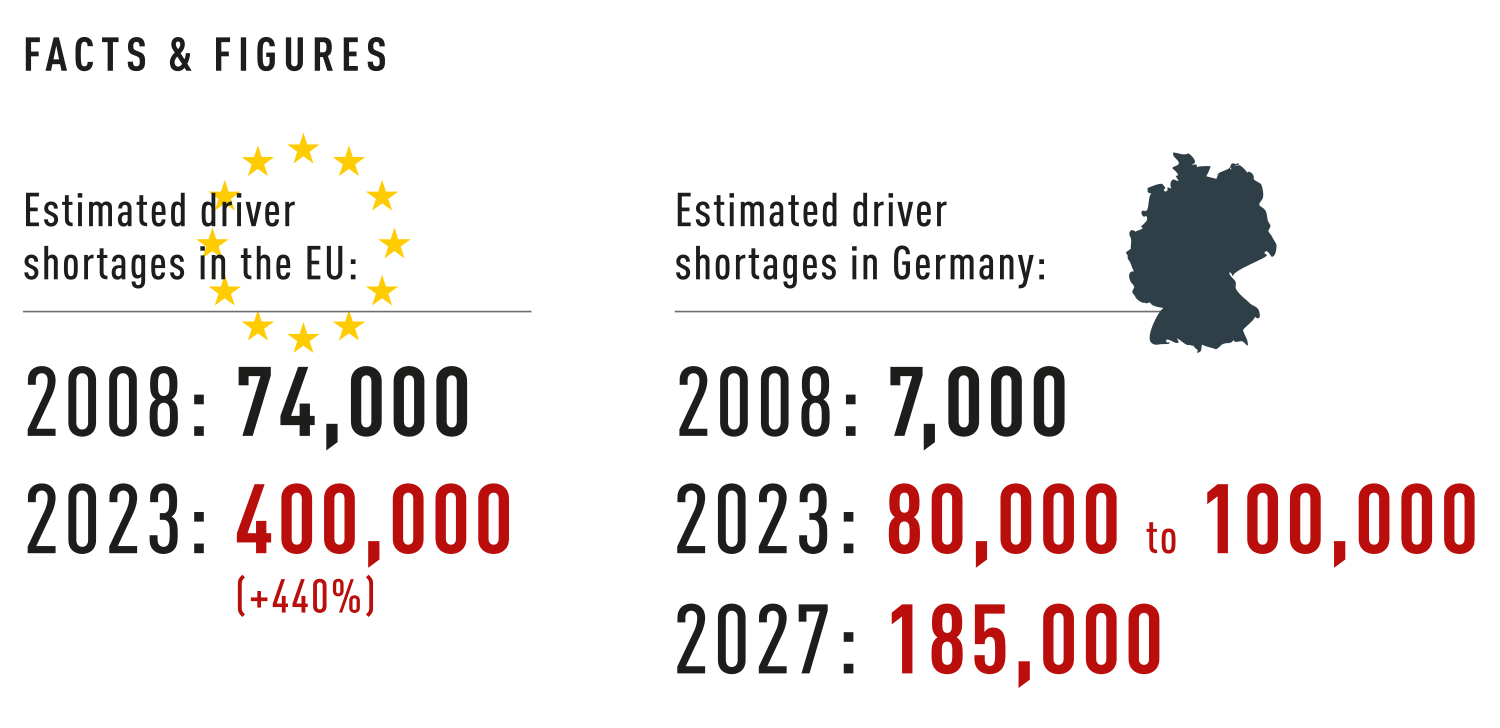
Source: International Road Transport Union (IRU), University of Koblenz/ Prof. Stefan Sell
Promoting the next generation of drivers
Filling vacancies – this is an issue that a recycling firm such as REMONDIS has to tackle as well. Collecting and processing recyclable materials requires a large number of drivers. Drivers who must manoeuvre heavy, highly modern vehicles – such as side loaders, front end loaders, compactor vehicles and hook-lift trucks – through narrow streets and busy traffic every single day. Which means that the staff needed for these positions must be competent and, in the best case scenario, be prepared to stay at the company for many years.
New creative solutions are needed, therefore, to retain well-trained staff: REMONDIS’ Cologne-based company responsible for the Rhineland region is showing the way here having set up its own driving school at the end of 2021. Apprentices and REMONDIS employees can now take part in courses at REDRIVE GmbH to get ready for the category C/CE driving test and learn about the specific requirements of working in this industry. Thanks to this concept, REMONDIS Rhineland is getting itself fit for the future and helping to make the image of working as an HGV driver in the recycling sector more attractive. Family-friendly working hours are right at the top of the list of working conditions in this future-oriented industry.
“The truck drivers that we train drive in a more economical way and cause fewer accidents and less damage because they are taught to handle their vehicle in an environmentally friendly way and are better prepared for coping with inner city traffic.”
Reinhard Hohenstein, Managing Director REMONDIS Rhineland
On the one hand, the in-house driving school enables the apprentices to prepare for their category C/CE driving test. On the other, it also focuses on further training other members of staff.
The idea behind REDRIVE
“The whole of the apprenticeship course is organised and carried out centrally in our apprenticeship department with its four trainers,” explained Reinhard Hohenstein, managing director of REMONDIS Rhineland. The only thing that had been organised externally in the past was the category C/CE driving course so that the apprentices could drive the refuse collection trucks. “The advantage of bringing the truck driving course in-house is that we can teach them all about the special tasks they’ll have to carry out in this particular sector,” Hohenstein continued. “We can integrate specific driving skills and technical know-how into their training course.” A further idea behind this in-house training programme: “We’ve always placed great importance on the apprentices at the different REMONDIS Rhineland locations networking with each other. These small networks allow them to exchange experiences and help strengthen team spirit and the sense of being part of the company.” The combination of doing an apprenticeship and qualifying to become an HGV driver at REDRIVE further intensifies the contact the apprentices have to one another. “What’s more, we get to know the young people better which means we can support, advise and accompany them through their apprenticeship even better than before,” driving instructor André Bubenzer added. With the number of apprentices falling, there is a growing need to tailor the support they get. “Every apprentice is given a detailed report about what they have learned and what areas they still need to catch up on. By doing so, we have a relatively high pass rate in the exams.” The apprentices also enjoy an all-round carefree package: all administrative tasks, such as handing in documents and registering for exams, are carried out by the driving school.
One driving school, two pillars: driving licence & accelerated initial qualification courses
On the one hand, the in-house driving school enables the apprentices to prepare for their category C/CE driving test. On the other, it also focuses on further training other members of staff. “At the end of 2022, we began offering employees the possibility to take part in accelerated courses so that they can gain their initial qualification and become an HGV driver,” said Wolfgang Klein, logistics manager at REMONDIS Sustainable Services. He and Jonathan Pascoe, logistics operations manager at REMONDIS in Cologne, are both managing directors of the driving school. Employees, such as operators of fork-lift trucks and other machinery, can do an intensive course and then take the required Chamber of Commerce exam. “They have four to six weeks of non-stop classes to learn the theory and get the practical experience required by law and – once they’ve successfully passed the Chamber of Commerce exam – they can take their driving test soon after,” Klein explained.
Initial qualification & accelerated initial qualification for HGV drivers
According to the BKrFQG [Federal Professional Drivers‘ Qualification Act], drivers with Category C1, C1E, C and CE driving licences must be able to prove that they have a special initial qualification to be permitted to transport goods on public roads.
An apprenticeship to become a professional truck driver is considered the equivalent to this initial qualification for the carriage of goods. Newcomers to the profession or people being retrained, however, must participate in a training course and take an exam as set out in Section 3 of the BKrFQV. This can be done by taking part in an accelerated initial qualification course. Participants learn all the content that must, by law, be taught in a course lasting four to six weeks and are prepared for the Chamber of Commerce exam.
Added value thanks to overall concept
The company setting up its own driving school has proven to be very popular. 32 apprentices passed their HGV driving test during the school’s first 12 months. “All of them remained at REMONDIS after finishing their apprenticeship and are now supporting our team as well-trained drivers with a strong network of fellow drivers,” commented Jonathan Pascoe. And word is getting around about how successful the concept is. “REMONDIS West Region approached us to ask whether their apprentice truck drivers could take part in our driving courses,” Pascoe continued. “The first driver apprentices from the West Region participated in one of our theory courses in Cologne at the end of January and successfully passed their Category CE driving test in March.” REDRIVE purchased a further driving school truck at the beginning of 2023 – and a second driving instructor, Günter Lux, has joined driving instructor André Bubenzer to keep up with demand. And REDRIVE has organised a cooperation for apprentices from other regions so that the young people can stay in Cologne while they do their driving course.
A look ahead
Germany already finds itself facing a huge skills shortage today and demographic change will likely mean that this will only increase. “We believe that integrating refugees and people immigrating to the country is certainly an option. On a practical level, though, it’s not so easy,” explained Jonathan Pascoe. Publishers have begun issuing the exam papers in a number of different languages but that’s not enough on its own. “Driving instructors are needed who speak the same language as the apprentices – both for the theory classes and, above all, for the actual driving lessons – so that they can get the know-how across to them and ensure they have a sound apprenticeship.” An issue that all apprenticeship companies will find themselves having to face and that will be a challenge for society as a whole in the coming years. The first steps have already been taken. “The Chamber of Commerce is currently looking at whether to offer the accelerated initial qualification in eight languages,” Pascoe said. “And we, too, must start preparing for these integration measures as quickly as possible.”
REDRIVE purchased a further driving school truck at the beginning of 2023 to keep up with demand.
The REDRIVE courses
“We offer full-time truck driver training courses,” commented REDRIVE driving instructor André Bubenzer. The course participants can take their test and get their Category C/CE driving licence within a period of six to seven weeks. The course starts with two solid weeks of class. “We teach them the theory, the fundamental facts and technical know-how about the vehicles and they get their first feel of what it’s like to drive our two vehicles. They are able to use our software throughout the course to prepare for the theory exam. Each participant gets a detailed report from us about what they’ve already learned and what they need to catch up on. That way we get much higher pass rates in the exams.” Once they have passed their theory exam, they start having practical driving lessons in small groups of four apprentices soon after.
A holistic training concept
Right from the start, the driving school’s concept is geared towards taking over the apprentices after they finish their course. REDRIVE enhances the quality of the apprenticeship by teaching company values such as solidarity and mutual support. At the same time, it focuses on systematically further training and individually supporting the company’s own employees. “We want to keep on further developing our concept. This includes, for example, the accelerated initial qualification course which we began offering at the end of 2022. This might also include collaborations with external institutions such as job centres and vocational colleges. That would be two doors to the job market that lie very close to one another,” explained Wolfgang Klein.
Even if intensive research work is being carried out into new forms of mobility – such as autonomous driving – and the first vehicles are already on the road, Wolfgang Klein is convinced of one thing: “REMONDIS will need professional truck drivers for the foreseeable future. We operate in city centres on narrow roads and in very different types of urban areas with a whole host of different road users. Which means that we will continue to need our well-trained drivers to manoeuvre our fleet through the streets for a long time to come so that we can continue to deliver one of our core areas of expertise, namely collecting waste in urban areas.”
Three questions for…
Driving instructor André Bubenzer prepares the apprentices for their HGV driving test together with his colleague Günter Lux.
Where is your REDRIVE driving school actually based?
André Bubenzer: We use our rooms at REMONDIS’ branch in Cologne-Dünnwald. We have a seminar room there that can hold up to 16 people. What’s more, we also have a driving simulator there and two hook-lift trucks with driving school equipment for the practical lessons. One of the trucks is an environmentally friendly vehicle as it’s run on biogas. We purchased the second vehicle at the beginning of 2023 to be able to keep up with demand.
How does the driving school add value to the business?
André Bubenzer: Offering in-house HGV driving courses and accelerated initial qualification courses create a whole host of advantages for the company. The apprentices get the best possible preparation and get to learn the practical side of the job they’ll do at our company. And, of course, we get to know them really well. What’s more, by offering the accelerated initial qualification courses, we can also help employees that are already working at the company to qualify as an HGV driver.
What has the feedback been like after 1½ years of REDRIVE?
André Bubenzer: The feedback from both the course participants and the branches taking part has been positive across the board. We’re also getting more and more enquiries about our services from other REMONDIS branches. We’re definitely on to a good thing here with REDRIVE.

Image credits: image 1: Adobe Stock: Aleksandr Kondratov; image 2, 3: Adobe Stock: pingebat; images 4–9: © REMONDIS


